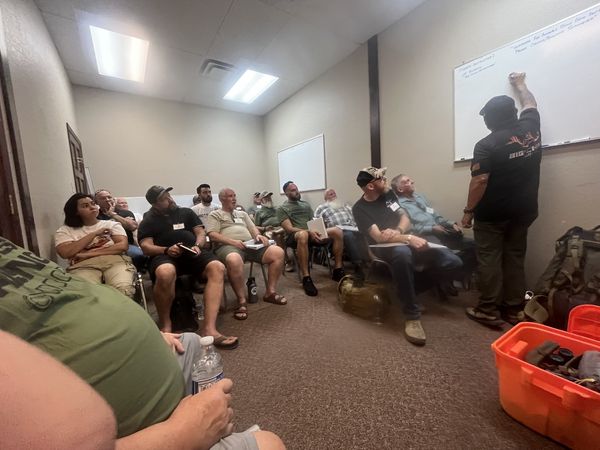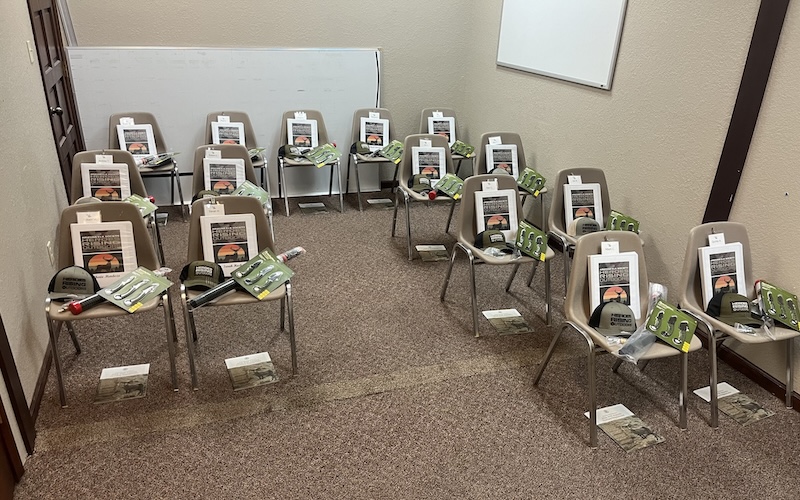Tuesday, July 9, the Arizona Elk Society and Heroes Rising Outdoors held its first ever series of hunting classes. This is going to be a 4-week series that teaches our attendees everything from preparing for the hunt all the way to processing the meat. We had 16 of our 17 veterans that signed up in attendance.
Our first session had Tim G. and Cliff S. as the instructors, and they did a great job. Tim explained how to prepare for the hunt before you even get into the field, even long before the season starts and demonstrated the necessary items to pack for a hunt. He also explained the various types of camouflage and the difference between desert styles and hardwood styles. He also went over the safety equipment that you need to have.
Cliff was our 2nd half instructor for the day and he went over various parts of the regulations book, explaining some items that are easily overlooked. He stressed heavily to read and know the book, know the area you are hunting, know the rules for each area because it is the hunter's responsibility. He also went over different types of optics to have and how to work those. The last thing that he touched on was ballistics, how to sight in a gun, and how to match the caliber that you are using to the animal you are hunting.
Next week we will be learning the habits and behaviors of big game animals, their habitats, track, and scat identification, and shot placement.
Tuesday July 16 the Heroes Rising Outdoors Program held its 2nd of 4 hunting classes. Our instructor for the week was Byron C. He did an excellent job explaining each species of big game animal, their habits, migration patterns, habitats, track and scat identification, preferred brows/foods and more. He also talked about some of his personal hunting experiences. The species he went over were whitetail and mule deer, elk, antelope, javelina, and turkey. Also, he talked about shot placement in the various positions you may find an animal, from quartering, straight on, broadside, etc. Our veterans are really enjoying this class and learning great skills from it to take into the woods.
Tuesday, July 23 the Heroes Rising Outdoors Program held is 3rd of 4 hunting classes. Our instructor for the week was JP V. He talked about hunting tactics and glassing, explaining in detail the 3 things to look for to find any species of animal. These 3 things are water, food, and shelter. He also explained such things as hunters for the most part look at things from a perspective of 3-4’ high and up, and how you need to look 4’ and under, especially when animals are bedded down. He interjected stories of how he grew up, his father and uncles, and how the art of hunting with modern technology has been forgotten or lost. He then taught standard optics setup and what he uses. He was very straightforward in that most people spend too much money on guns when they should spend the most money on optics. He talked about being an ethical hunter, and about how that is different for everyone, depending on their capabilities. The last things he shared were how most times when glassing, you start at the furthest point, when you need to start at the closest point and work further out and when calling make sure not to over call. JP shared that cow calls are most of the time more effective than bugling. Only in certain scenarios a bugle call is good, such as during the rut. Our last class next week we will go over processing, packaging, preparing your animal for taxidermist, skinning, and field dressing techniques.
Tuesday, July 30 the Heroes Rising Outdoors Program wrapped up its inaugural hunting classes. The instructors for the week were Andy M., Cliff S., and Russ J. We started with how to track  an animal after the shot and what to look for. Even if there is no trail, look for broken branches, tracks, grass/soil disturbed, and how to find the nearest water source because a wounded animal tends to run downhill towards water. We then went into what all you need in a pack for field dressing and quartering an animal. We talked a little bit about what is expected from a taxidermist if you plan on doing a shoulder mount, life size mount, rug, European mount, or just a horn mount. From there, we went into how to properly skin an animal and the 2 different types of field dressing an animal. Our last topic of the class was discussing the different cuts of meat you can get and where to get them from and how. We closed out our last class with presentations of certificates to the attendees. Overall, this was a great 4-week class and the participants learned a lot about hunting different species. We would like to thank the participants and the instructors who took the time to come to this class and look forward to next year’s class!
an animal after the shot and what to look for. Even if there is no trail, look for broken branches, tracks, grass/soil disturbed, and how to find the nearest water source because a wounded animal tends to run downhill towards water. We then went into what all you need in a pack for field dressing and quartering an animal. We talked a little bit about what is expected from a taxidermist if you plan on doing a shoulder mount, life size mount, rug, European mount, or just a horn mount. From there, we went into how to properly skin an animal and the 2 different types of field dressing an animal. Our last topic of the class was discussing the different cuts of meat you can get and where to get them from and how. We closed out our last class with presentations of certificates to the attendees. Overall, this was a great 4-week class and the participants learned a lot about hunting different species. We would like to thank the participants and the instructors who took the time to come to this class and look forward to next year’s class!


